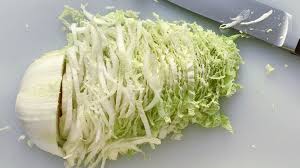How to Make Authentic Homemade Sauerkraut
The History and Philosophy of Sauerkraut
Making authentic homemade sauerkraut is inextricably linked to Germany’s long culinary history, which dates back centuries. Fermenting cabbage with salt was not only a cooking technique, but also a crucial preservation method before the invention of refrigeration. In ancient times, making authentic homemade sauerkraut was a tradition passed down through generations, ensuring people’s nutritional needs during the winter. By utilizing fermentation, people could enjoy fresh vegetables despite the long winter.
Making authentic homemade sauerkraut holds philosophical significance in European society, particularly in Germany and Austria. The lengthy fermentation process is seen as a symbol of patience and respect for nature. A simple cabbage can be transformed into a highly nutritious meal with just a little salt and time. From this, making authentic homemade sauerkraut has developed into a timeless cultural identity.
Basic Ingredients for Making Sauerkraut
To understand how to make authentic homemade sauerkraut, we need to know the basic ingredients. Essentially, the main ingredients are simply fresh cabbage and coarse, non-iodized salt. However, many people add spices such as caraway seeds, dill seeds, or bay leaves to impart a more complex aroma. In Eastern European traditions, authentic homemade sauerkraut can even be combined with grated carrots or green apples for a natural sweetness.
The success of making authentic homemade sauerkraut depends heavily on the quality of the cabbage used. Winter cabbage is typically denser and more watery, allowing for perfect fermentation. Salt serves a dual purpose: drawing out the liquid from the cabbage while creating a safe environment for beneficial bacteria to thrive. With this simple combination, authentic homemade sauerkraut produces a distinctive, fresh, sour flavor.
The Fermentation Process Determines the Flavor
The most important step in making authentic homemade sauerkraut is the fermentation process. After the cabbage is thinly sliced and mixed with salt, it must be pressed until it releases its natural juices. This juice will serve as a natural salt solution for the fermentation process. Making authentic homemade sauerkraut usually takes at least a week, but the longer it ferments, the stronger the sour flavor will be.
Fermentation in making authentic homemade sauerkraut relies on lactic acid bacteria naturally present on the surface of the cabbage. These bacteria multiply in the absence of oxygen, converting the sugars in the cabbage into lactic acid. This is what gives the cabbage its fresh flavor and allows it to last longer. During this process, making authentic homemade sauerkraut also produces natural probiotics that are beneficial for digestive health.
Health Benefits of Sauerkraut

Besides its delicious taste, making authentic homemade sauerkraut also offers numerous health benefits. Because it’s fermented, sauerkraut is rich in probiotics, which help maintain the balance of microbes in the gut. Probiotics in authentic homemade sauerkraut are believed to boost immunity, improve digestion, and even influence mental health through the gut-brain connection.
In addition to probiotics, authentic homemade sauerkraut also maintains vitamin C, vitamin K, and minerals like iron and manganese. The vitamin C in sauerkraut once saved European sailors from scurvy. By regularly consuming authentic homemade sauerkraut, the body can obtain natural nutrients rarely found in modern processed foods.
Flavor Variations and Serving Methods
Although simple, authentic homemade sauerkraut has many variations. In Germany, sauerkraut is often served with bratwurst sausages, boiled potatoes, or smoked meat. In Poland, there’s a dish called bigos that combines authentic homemade sauerkraut with chunks of meat and mushrooms. Even in the United States, sauerkraut is often a popular topping for hot dogs, providing a fresh, sour flavor that balances the savory meat.
Read also: Leeds United aim for first win against Everton
Nowadays, authentic homemade sauerkraut can also be customized to suit your tastes. Some people add ginger, chili peppers, or exotic spices to create unique flavors. Thus, while the basics of making authentic homemade sauerkraut remain the same, the end result can vary greatly depending on the maker’s creativity.
Practical Tips for Making at Home
To successfully make authentic homemade sauerkraut, there are several practical tips to keep in mind. First, use a clean fermentation container, such as a glass jar or ceramic container, as plastic containers can affect the flavor. Second, ensure the cabbage is completely submerged in the brine to prevent mold growth. Third, store it in a cool, dark place during fermentation.
Making authentic homemade sauerkraut does require patience, but the results are well worth it. Check the sauerkraut daily to ensure there are no floating debris. If there is, simply discard the top layer and let the process continue. By following these steps for making authentic homemade sauerkraut, anyone can enjoy traditional European flavors right from their own kitchen.
Furthermore, for those of you who enjoy culinary exploration, trying to make authentic homemade sauerkraut can be a rewarding experience. Just like searching online for information about traditional world foods, we sometimes also find interesting references from sites like Link Ampmwin, which offer a variety of unique reviews. This proves that cooking isn’t just about taste, but also a continually evolving learning experience.


